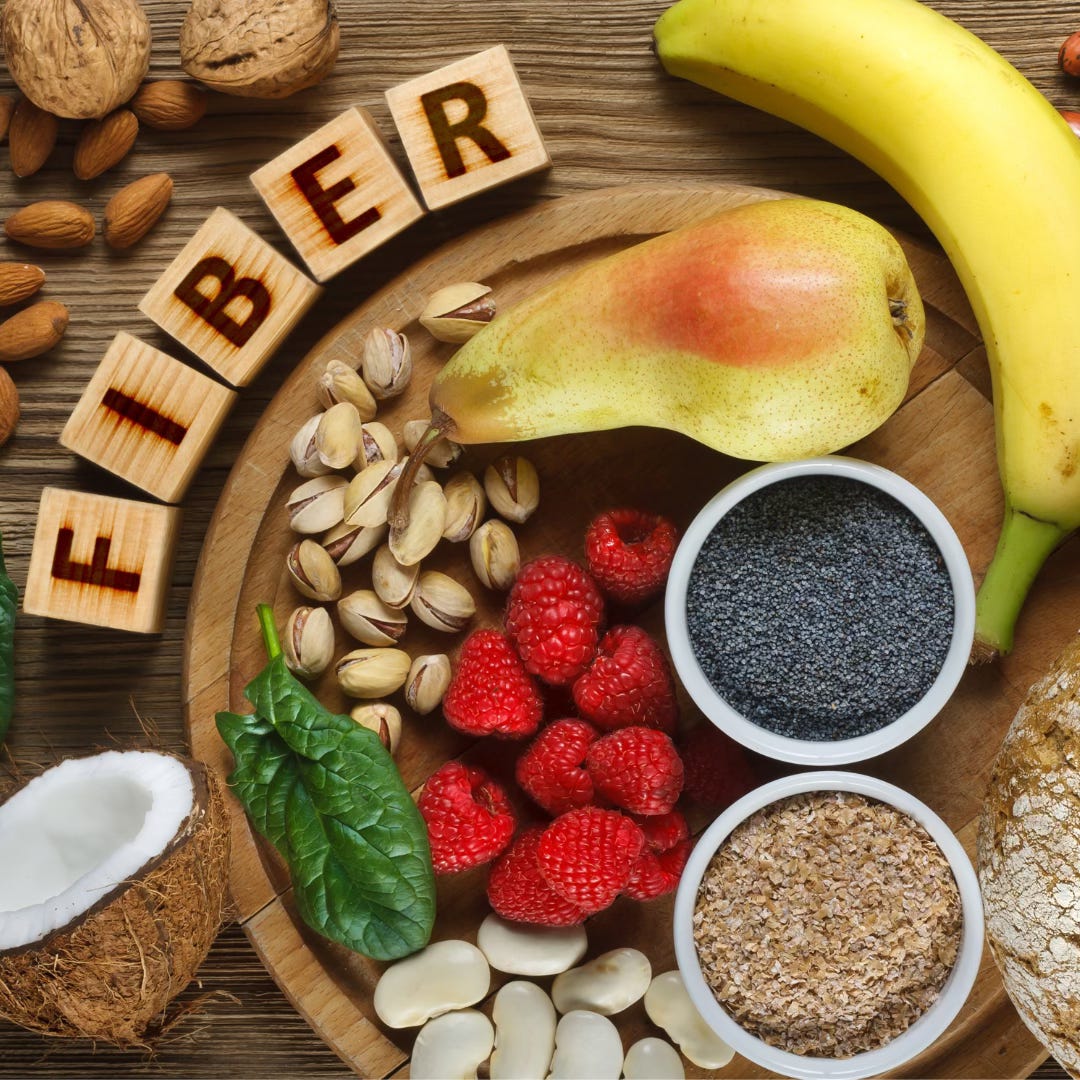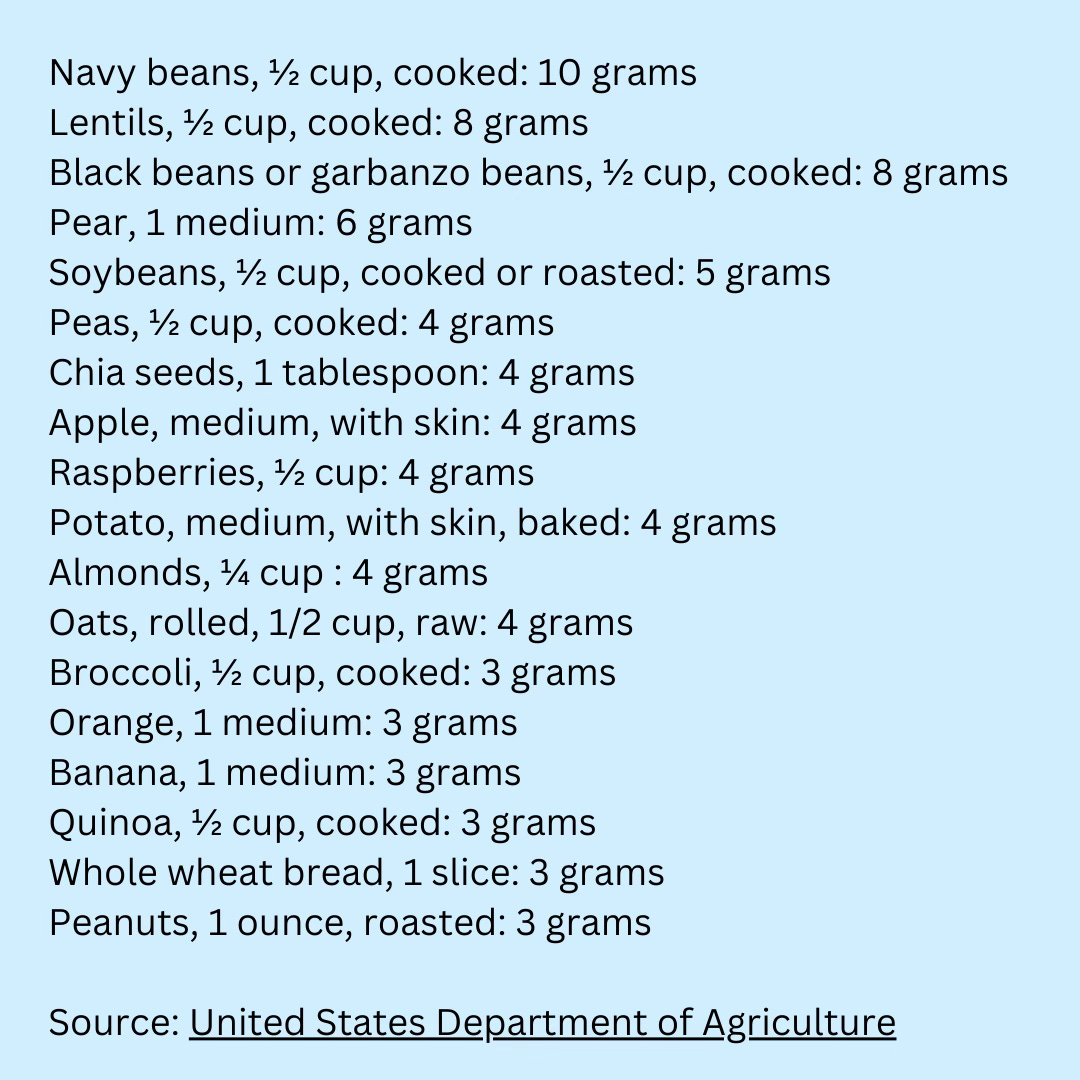Fiber deserves far more respect than it gets. For all that fiber does to support health, it’s one of the most neglected nutrients.
Most of us fail to eat enough plant foods to get the fiber we need. A mere 5% of the U.S. population consumes the amount of daily fiber recommended by experts and most of us eat just half of what we require.
With such an emphasis on adequate (and possibly, excessive) protein intake for midlife women, fiber can be overlooked. Foods with fiber are also full of carbohydrate and fruits, vegetables, beans, lentils, and grains often get the shaft in the pursuit of protein.
Our abysmal record with fiber is a massive missed opportunity for better health, especially after menopause occurs. Here’s why fiber is fundamental.
What is Fiber?
Fiber is a type of carbohydrate that we don’t digest. It’s found only in plant foods. There are two kinds of dietary fiber, which is categorized based on how it interacts with water. Soluble fiber dissolves in water and insoluble fiber does not. Each type of fiber plays different roles in wellbeing.
The benefits of fiber originate in the gut and have far-flung effects in the body. Insoluble fiber helps reduce constipation, hemorrhoids, and diverticulosis by adding bulk to stools, making them easier to pass and reducing straining. In promoting regularity, insoluble fiber helps to limit exposure to carcinogens that may give rise to colorectal cancer.
Soluble fiber’s job is to feed beneficial bacteria, also known as probiotics, that live in the gut. Soluble fiber is also called prebiotic fiber. Bacteria ferment soluble fiber to extract its energy in order to produce compounds including vitamin K, several B vitamins, and neurotransmitters, substances that relay messages between nerve cells throughout the body.
Beneficial bacteria also make short chain fatty acids, which help reduce the risk for infection, boost the absorption of calcium and magnesium in the colon, and regulate the immune system. Short chain fatty acids support the strength of the gut barrier, lowering the risk for colon cancer, and they play a role in reducing inflammation and infection in the gut and the rest of the body.
How Fiber Supports Better Health
Fiber is beneficial for menopausal and midlife women in many ways, including the following.
Weight control. Women often gain weight in midlife, especially around the midsection. Soluble fiber may help keep you fuller for longer and make weight control easier.
Research published in Obesity in 2013 found that an increased intake of soluble fiber combined with 30 minutes of exercise two to four times weekly slowed visceral fat (aka belly fat) gain over a 5-year period.
A 2018 Nutrition study of adults with obesity asked people to eat 35 grams of total fiber daily and consume adequate protein (the current RDA for protein, which is 0.8 grams per kilogram of body weight) without counting calories. Researchers found that the participants consumed an average of 265 fewer calories daily, and lost modest amounts of weight over the 12-week study period.
A 2024 study published in the Nutrition Journal found an association between eating black beans, kidney beans, chickpeas and/or pinto beans and a lower body mass index and smaller waist circumference. The researchers also found that bean eaters consumed more fiber as well as magnesium, calcium, and potassium than non-bean eaters. The authors concluded that 2/3 cup of beans daily produced the positive results. However, eating less than 2/3 cup is also helpful for meeting fiber needs.
Blood glucose control. Declining estrogen levels increase the risk of insulin resistance. Insulin resistance is a risk factor for type 2 diabetes. It occurs when cells fail to respond appropriately to the hormone insulin, leading to inadequate uptake of glucose from the blood stream. Insulin resistance causes blood glucose levels to remain higher than normal, triggering the pancreas to produce more insulin to try to bring them down. With time, the pancreas can no longer make the amount of insulin required to reduce blood glucose levels.
The soluble fiber in food forms a gel with water in your digestive tract to slow down digestion, possibly decreasing the amount of insulin you need to process the glucose in your blood stream, and helping to keep blood glucose levels with a normal range.
Menopause symptoms. Microbes in the gut that feed on soluble fiber affect estrogen levels in the bloodstream.
The estrobolome is all the genes in gut bacteria that are capable of metabolizing estrogen. When estrogen is conjugated it can be excreted from the body. Several types of gut bacteria contain enzymes that deconjugate estrogen. Deconjugation allows estrogen to be absorbed back into the bloodstream which may reduce perimenopause symptoms, according to a 2022 review published in the International Journal of Womens Health.
A strong gut barrier that keeps gut contents out of the blood stream is key to overall health. A 2020 Journal of Clinical Investigation study followed 65 women from the Study of Women’s Health Across the Nation (SWAN) throughout their menopause transition and found that gut permeability increased during the menopause transition. In the study, greater gut permeability was associated with more inflammation and lower bone mineral density, a red flag for osteopororis. Maintaining a healthier gut with a consistently adequate fiber intake may help you avoid these issues.
Chronic illness. The risk for chronic conditions increases with age, and menopause boosts your chances for heart disease and osteoporosis. A 2016 Journals of Gerontology Series A study that followed 1,600 people ages 49 and older for a period of 10 years found that those with the highest fiber intake had the fewest chronic diseases, including heart disease, type 2 diabetes, and cancer, less disability and depression, and better brain function that those who consumed the least amount of fiber.
In a 2022 Nutritional Neuroscience study of more than 3,700 midlife men and women, researchers concluded that a higher fiber intake, especially soluble fiber, was associated with the lowest risk for developing dementia during a 20-year period.
How Much Fiber You Need and How to Get It
Suggested daily fiber intakes are based on calories consumed. The recommended amount is a minimum of 14 grams of fiber for every 1,000 calories, which amounts to at least 25 grams of fiber on an 1,800-calorie eating plan and 28 grams or more of fiber daily on a 2,000-calorie eating plan.
Expert fiber recommendations don’t differentiate between soluble and insoluble fiber. Plant foods contain both kinds of fiber, although some supply more of one type. Apples, asparagus, bananas, berries, beans (legumes), brown rice, carrots, chia seeds, citrus fruits, figs, flaxseed, kiwi, lentils, oatmeal, peas, quinoa, soybeans (edamame), sweet and white potato, whole grain bread and pasta are notable for their soluble fiber. Plant foods also provide polyphenols, compounds that, like soluble fiber, foster the growth of beneficial gut microbes.
The Nutrition Facts panel on food labels of packaged foods like cereal, pasta, and rice alerts you to the amount of dietary fiber per serving. Here’s a list of foods and their fiber content to help you include the fiber you need every day.
Try these simple tips to include more fiber:
• Swap ½ cup fresh raspberries for jelly in a peanut butter sandwich.
• Add 3 tablespoons of chia seeds to foods such as oatmeal, cold cereal, smoothies, and salads throughout the day.
• Puree a can of drained beans or 2 cups of cooked lentils and add to soups and stews, or add them whole.
• Munch on roasted edamame or popcorn (which is a whole grain) instead of pretzels or snack chips.
• Stir ½ cup whole grain cereal into yogurt for extra crunch and fiber.
• Make your own trail mix with 1/4 cup each: whole grain cereal, raisins, and peanuts.
If you’re not eating the suggested amount of fiber, start slowly to achieve your daily goal. Try adding about five grams a week and drink lots of water to help move it through your body. Simply adding fiber without fluid can cause constipation.
Foods with Added Fiber
I favor getting fiber from raw and lightly processed foods because they’re usually packed with other nutrients such as protein, vitamins, minerals, and phytonutrients that support overall health. In addition, the fiber that occurs naturally in food is a mixture of prebiotic fibers that feed a variety of beneficial gut bacteria, whereas fibers that are added to foods such as packaged cereal bars, brownies, and carbonated drinks, are a single type.
Certain added fibers, such as inulin, can cause gas and bloating when fermented in the gut. People with irritable bowel syndrome and other digestive issues may be sensitive to added fibers. Food labels list added prebiotic fibers in the ingredient list of packaged foods, but they don’t have to tell you how much is in a serving of the food.
If you’re having trouble satisfying your daily fiber requirements, you may think fiber supplements can help, but they may not have the same effect on health. A 2021 review in Nutrients suggests that high fiber diets are more effective overall than fiber supplements and other diets for preventing chronic conditions such as type 2 diabetes.
Are you getting enough fiber? Let me know!







May I ask you a question? Does eating chia seeds or taking psyllium husk prevent absorption of nutrients like calcium or magnesium? I’ve been eating chia seeds daily for years and just recently added some psyllium but then I read beware of these two things. You cannot believe everything you read so I hope I can continue eating them!!
I eat a plant based diet primarily and am fairly certain I get more than enough fiber. A daily smoothie often has whole oats, white beans or silken tofu for protein, chia and flax seed, as well as raspberries, mango and blueberries. At each meal, I challenge myself to try and add as many vegetables as possible. I always can tell when I haven't kept up with the fiber, my tummy is pretty clear about telling me!